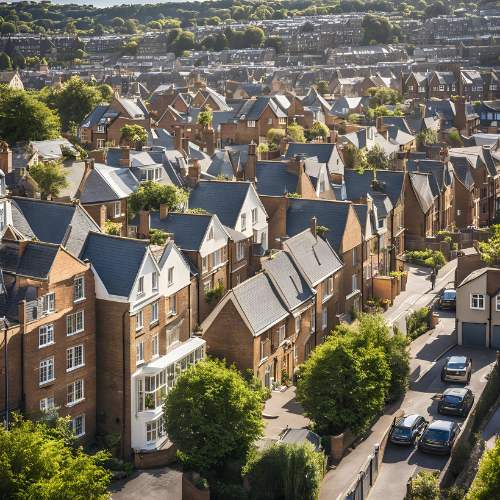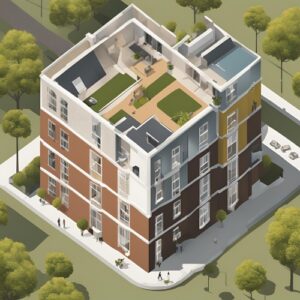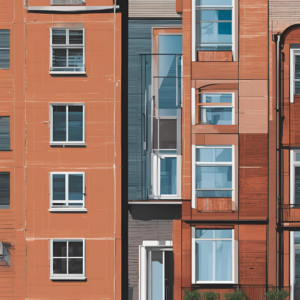Leasehold Property UK: Key Insights and Investment Considerations for 2025

Leasehold properties are a key part of the UK housing market, especially for flats and shared buildings. In this ownership model, the property is owned for a fixed term, while the land remains under the freeholder’s control.
Recent reforms, including the abolition of escalating ground rents and streamlined lease extensions, are transforming the leasehold system, making it more transparent and appealing.
For landlords, these changes present new opportunities and considerations in a competitive property market. This guide breaks down everything you need to know about leasehold ownership in 2025.
What Is Leasehold Property UK?
Leasehold property is a common ownership structure in the UK where the property is owned for a fixed period, but the land is retained by the freeholder. Understanding the leasehold system is essential for buyers and investors.
- Definition of Leasehold: Leaseholders own the property for a specified lease term, usually ranging from 99 to 125 years or more. At the end of the lease, ownership reverts to the freeholder unless extended or purchased outright.
- Prevalence of Leasehold: Leasehold ownership is typical for flats and maisonettes due to shared building maintenance and communal areas, though some houses are also sold as leasehold.
In 2025, leasehold properties remain a central topic in the UK property market due to reforms introduced in recent years. These changes focus on enhancing transparency, reducing financial exploitation and creating a fairer system for both leaseholders and freeholders.
The abolition of escalating ground rents for new leases has significantly alleviated financial pressure on buyers, making leasehold properties more predictable and attractive.
Additionally, reforms are streamlining the lease extension and freehold purchase processes, addressing historical complaints about high costs and legal complexities. These improvements have strengthened market confidence, encouraging both homeowners and investors to reconsider leasehold properties as viable options in high-demand areas.
Leasehold vs Freehold: Key Differences
Choosing between leasehold and freehold ownership requires understanding their core distinctions. Leasehold properties offer advantages in certain situations but come with added responsibilities.
- Ownership Duration: Leasehold provides ownership for a fixed period, while freehold offers indefinite ownership of both the property and land. Leaseholders must be mindful of the remaining lease term, as it impacts the property’s value.
- Costs: Leasehold properties involve additional expenses such as ground rent, service charges and lease extension fees. Freehold properties typically have fewer ongoing costs but require the owner to manage all maintenance.
- Practical Applications: Leasehold is often more affordable, especially for first-time buyers in urban areas, while freehold is ideal for those seeking full control over their property.
| Category | Leasehold | Freehold | Similarities |
|---|---|---|---|
| Ownership Duration | Ownership is for a fixed term (e.g., 99–125 years). Ownership reverts to the freeholder when the lease expires unless extended. | Ownership is indefinite and includes the land and property. | Both grant legal ownership rights for the property during the ownership term. |
| Property Type | Common for flats and maisonettes where shared responsibilities exist for communal areas. | Typical for houses where the owner has full responsibility for maintenance. | Both may involve responsibilities for property upkeep, though on different scales. |
| Costs | Includes ground rent, service charges, and potential lease extension fees. | Generally has fewer recurring costs but requires owners to fund all maintenance directly. | Both require property taxes and potential maintenance investments. |
| Maintenance Responsibility | Shared responsibility with other leaseholders; the freeholder often manages the maintenance of communal areas. | Full responsibility for all property and land maintenance. | Both require maintenance, though leasehold maintenance is more structured. |
| Control | Limited control over property alterations; freeholder consent is often required. | Full control over property alterations, subject to planning permissions. | Both may need to adhere to legal or planning regulations depending on the property. |
| Affordability | Typically more affordable upfront, making it appealing for first-time buyers. | Higher upfront costs due to full ownership. | Both can be viable options depending on the buyer’s financial situation. |
- Leasehold is suitable for flats or shared properties and may appeal to buyers seeking lower upfront costs in urban areas but comes with ongoing fees and less control.
- Freehold is ideal for buyers who want full ownership and control over the property, particularly houses, though it typically involves higher initial investment and responsibility for maintenance.
Read more about the differences between leasehold and freehold property.
Understanding Leasehold Property Reforms
Leasehold property reforms introduced in recent years aim to address historical issues such as escalating ground rents and challenging lease extensions. These changes will significantly impact the leasehold market in 2025, benefiting both leaseholders and landlords.

- Abolishment of Ground Rent: New legislation has capped or eliminated ground rents for most new leases, reducing financial burdens on leaseholders and making ownership more predictable.
For landlords, this means adapting to a rental model that no longer relies on ground rent income. - Streamlined Lease Extensions: Simplified processes for extending leases or purchasing the freehold have reduced costs and legal complexities for leaseholders.
For landlords, these changes mean they may face an increase in leaseholders opting to buy out their leases, potentially reducing long-term revenue from ground rents. However, landlords who facilitate the process may build better relationships with tenants and benefit from faster transactions. - Impact on Market Confidence: Reforms have improved transparency and fairness, addressing long-standing concerns about the leasehold system. This makes leasehold properties more attractive to buyers and investors, ultimately benefiting landlords by increasing demand for leasehold properties. A more competitive market could also lead to higher property values in key areas.
Key Financial Considerations for Leasehold Properties
Owning a leasehold property involves ongoing costs that both landlords and leaseholders need to understand. These expenses can significantly impact profitability and property value, making careful planning essential.

- Ground Rent: Ground rent is a fee paid by the leaseholder to the freeholder, often ranging from £50 to £250 per year for older leases. However, escalating ground rents in some historic leases have caused financial strain, leading to legislation that caps or abolishes ground rent for new leases. For landlords, this means a reduction in passive income from new properties, encouraging a shift toward generating revenue through service charges or other means.
- Service Charges: These charges cover communal maintenance, such as cleaning shared areas, repairs and upkeep of lifts or gardens. Service charges can vary significantly, with urban flats often incurring higher costs, sometimes exceeding £2,000 annually. Landlords managing multiple leasehold properties should ensure transparency in service charge allocation to maintain good relationships with tenants and comply with legal obligations.
- Lease Extension Costs: Extending a lease is crucial for maintaining property value, especially when the lease length falls below 80 years. For example, extending a 75-year lease on a flat valued at £300,000 could cost approximately £20,000–£25,000, including valuation fees and legal costs. Landlords may face reduced marketability if they allow leases to run too short, emphasising the importance of early action.
Maintenance Fees: These fees cover the ongoing upkeep of the property, such as roof repairs or structural maintenance, and are separate from service charges. For example, a landlord managing a block of flats might charge £1,500 annually per flat for major repairs, ensuring long-term property sustainability. Landlords need to budget for these expenses to maintain tenant satisfaction.
Common Concerns About Leasehold Properties
Leasehold ownership can present unique challenges for landlords and property owners, particularly around leasehold depreciation, control over property alterations and lease expiry. Understanding these risks and taking proactive measures can help mitigate their impact.

- Leasehold Depreciation: A leasehold property’s value decreases as the lease length shortens, especially when it drops below 80 years. For example, a flat with a 75-year lease might sell for significantly less than one with a 125-year lease, due to higher lease extension costs for the buyer. Landlords should monitor lease durations and consider extending leases early to maintain property value and market appeal.
- Limited Control Over Property Alterations: Leaseholders often need the freeholder’s permission to make significant changes to their property, such as installing new windows or altering internal layouts. These permissions can come with added costs, such as administration fees. Landlords managing leasehold properties should communicate clearly with tenants about alteration policies and consider offering flexibility to foster goodwill.
- Lease Expiry and Reversion: When a lease expires, ownership of the property reverts to the freeholder, leaving the leaseholder with no property rights. This risk can be mitigated by extending the lease well before expiry or purchasing the freehold. For example, a leaseholder with 15 years remaining should begin the lease extension process immediately to avoid higher costs or losing ownership altogether.
- Tips for Mitigating Risks: Landlords and leaseholders can take proactive steps to reduce risks associated with leasehold properties. Purchasing the freehold, either individually or collectively with other leaseholders in the same building, eliminates ground rent and enhances control over property management. Additionally, maintaining transparent records and ensuring good communication between landlords and tenants can help resolve potential conflicts early.
Investment Potential: Leasehold Properties in 2025
Leasehold properties can still be a lucrative investment in 2025 under the right circumstances. Changes in legislation and opportunities in specific markets make them appealing for buyers and investors looking for affordability and growth potential.
- Affordable Entry Points in High-Demand Areas: Leasehold properties typically have lower upfront costs compared to freehold, making them an accessible option for investors and first-time buyers.
For example, a leasehold flat in London may be priced significantly lower than a comparable freehold house in the same area, offering an affordable way to enter a competitive market. This affordability allows landlords to purchase multiple properties, diversifying their portfolios.
- Opportunities in Upcoming Housing Developments: Many urban housing developments use the leasehold model to manage shared amenities like parking, gyms, and communal spaces.
These developments often cater to young professionals, ensuring strong rental demand and steady cash flow for landlords. For instance, new developments in Manchester’s city centre are offering leasehold flats with high rental yields due to the growing demand for centrally located housing.
- Impact of Reforms on Market Attractiveness: Recent leasehold reforms, such as the abolition of escalating ground rents and streamlined lease extensions, have made leasehold properties more transparent and predictable.
These changes reduce financial uncertainty for investors and improve buyer confidence. Landlords who adapt to these changes can benefit from increased demand and a larger pool of potential tenants, particularly in areas where leasehold properties dominate the market.
Leasehold Property FAQs
- Is It Worth Buying a Leasehold House in the UK?
Yes, leasehold houses can still be a worthwhile investment, particularly in areas where freehold properties are scarce or unaffordable. However, landlords should carefully review the lease terms for restrictive clauses, such as escalating ground rents and factor in costs like service charges. With recent reforms, leasehold houses have become more transparent, but landlords should ensure the property offers strong rental demand to justify the investment. - What Are the Disadvantages of Buying Leasehold Property?
The main disadvantages include additional costs such as ground rent, service charges, and potential fees for lease extensions. Limited control over property alterations can also be a drawback for landlords who prefer more flexibility. However, these properties often come with lower upfront costs and access to high-demand areas, which can offset these disadvantages for landlords with a clear investment strategy. - How Long Should a Leasehold Last to Maintain Value?
A leasehold should ideally have at least 80 years remaining to maintain its value and appeal to buyers. Below this threshold, the property’s value can decline significantly and lease extension costs increase due to “marriage value.” Landlords should extend leases early or consider purchasing the freehold to preserve the property’s marketability and profitability. - Can You Convert Leasehold to Freehold?
Yes, landlords and leaseholders can purchase the freehold, either individually or collectively, through a legal process called enfranchisement. This eliminates ground rent and provides full control over the property but requires upfront costs that depend on the property’s value and lease length. While costly, buying the freehold can significantly enhance the property’s value and long-term viability.
Find answers to more FAQs on leasehold property in this article.
Navigating the Leasehold Property Market in 2025
The leasehold property market will continue to evolve in 2025, with significant reforms enhancing transparency, reducing financial burdens and improving market confidence. From understanding the distinctions between leasehold and freehold ownership to navigating costs like ground rent and lease extensions, landlords must carefully evaluate the opportunities and challenges associated with leasehold properties.
As reforms make leasehold ownership more appealing and manageable, this is an opportune time for landlords to explore affordable entry points, leverage new developments and maximise investment potential. By staying informed and proactive, landlords can mitigate risks such as leasehold property depreciation and limited control, while positioning themselves for success in a competitive market.
For expert advice in buying or managing leasehold get in touch with our team or do further reading on the basics of property leaseholds.

